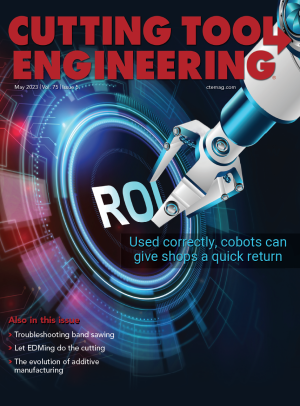When the going gets tough, the sparks fly at many machine shops. Those sparks are the signature of electrical discharge machining, a process called on by those tackling some of the biggest challenges presented by metal cutting.
Common techniques of this kind include wire EDM and sinker EDM. The choice between the two depends on the machining task at hand. Both have their strengths and downsides, and both have been enhanced by recent developments unveiled by companies that make EDM machines.
Suitable for machining conductive materials, EDM works by producing current discharges between two electrodes — a tool and a workpiece — with different polarities that are separated by a dielectric fluid. When the electrodes are close to each other, sparks are generated, causing high-temperature spikes that melt and remove material from the workpiece.
The tool electrode in the wire EDM process is normally a thin wire. Today, the diameter of an EDM wire is typically 0.01", said Eric Ostini, business development manager at Lincolnshire, Illinois-based GF Machining Solutions LLC, which sells EDM machines. As the EDM process melts material, the wire continues to unspool and move through the workpiece to cut the desired through-cavity shape. The process can include an initial roughing pass and a number of “skim” passes to improve the accuracy and surface finish of the cavity, he explained.
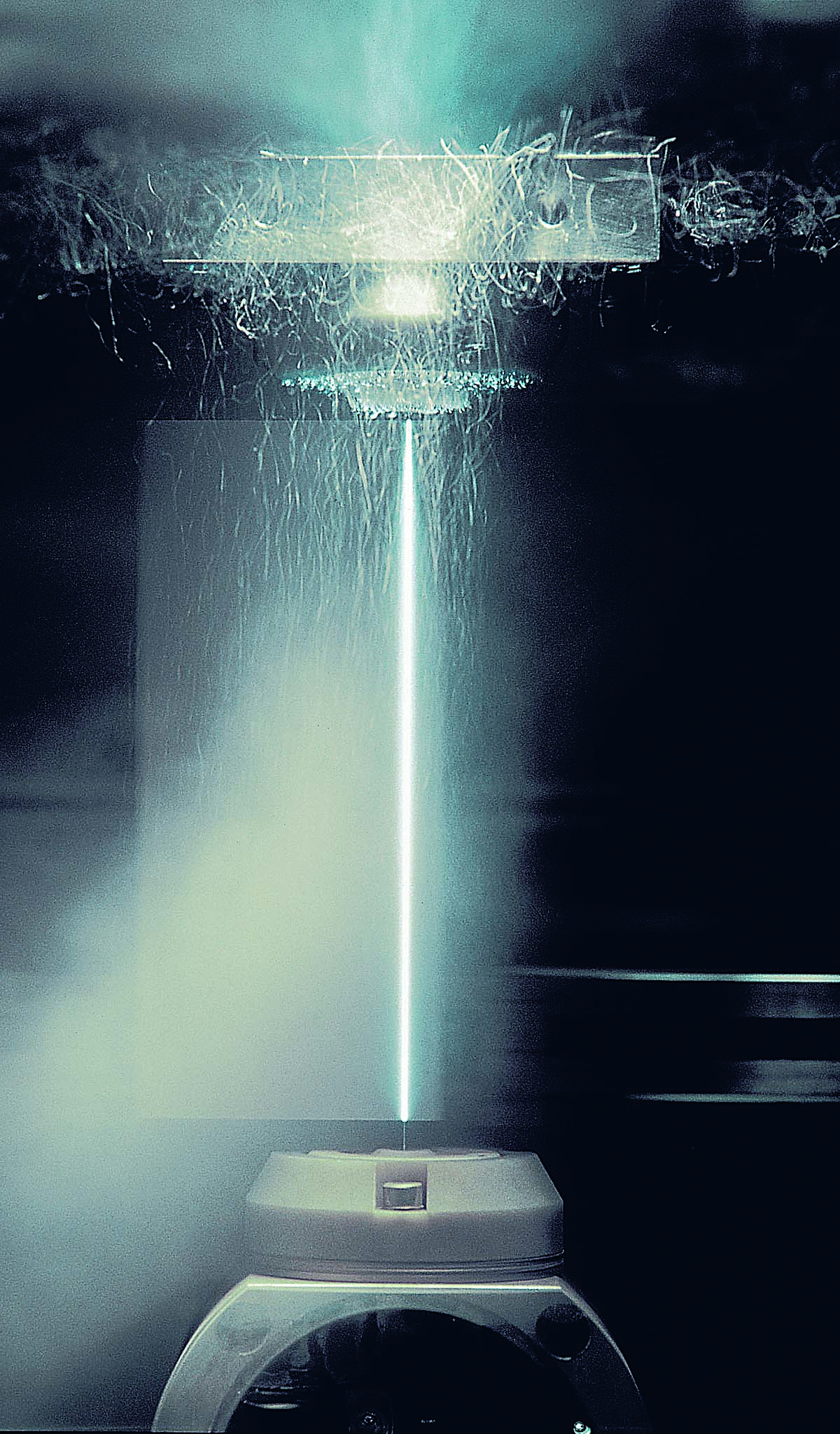
Unlike wire EDM, sinker EDM — also known as die-sinker EDM and ram EDM — normally is used to create blind holes or cavities. The shape of the tool electrode in sinker EDM is the inverse of the cavity shape that the machinist wishes to create. The electrode is plunged into the workpiece material, which is immersed in a dielectric fluid.
“You have to manufacture the electrode out of materials like graphite, copper and copper tungsten, and you need to machine the shape that you want to burn, typically on a CNC mill,” said Brian Coward, EDM product manager at Makino Inc., a machine manufacturer in Mason, Ohio. “So the cost for sinker is going to be higher than it would be for wire.”
In fact, he added, wire EDM is actually very cost-efficient compared with sinker.
“There is a cost for the spool of wire,” Coward said, “but it’s much cheaper than manufacturing an electrode.”
Adding to the electrode costs of sinker EDM is the fact that more than one of them probably will be needed.
“Usually,” Ostini said, “you’re using one electrode as a rougher, then a second electrode as a semifinisher and maybe even a finishing electrode to get to the final size and surface finish that you’d like to achieve.”
Pluses and Minuses
So why use EDM? When an application calls for very high accuracy and precision, there may be no other choice.
When EDM is employed, “we’re talking about holding ±0.0002" in the operations,” said George Brown, Northeast and Southeast regional manager at Pittsburgh-based Vollmer of America Corp., which sells EDM machines for making cutting tools. “Basically, it’s on the same level as grinding, but with grinding you can’t always get the precision contours that you can with EDM.”
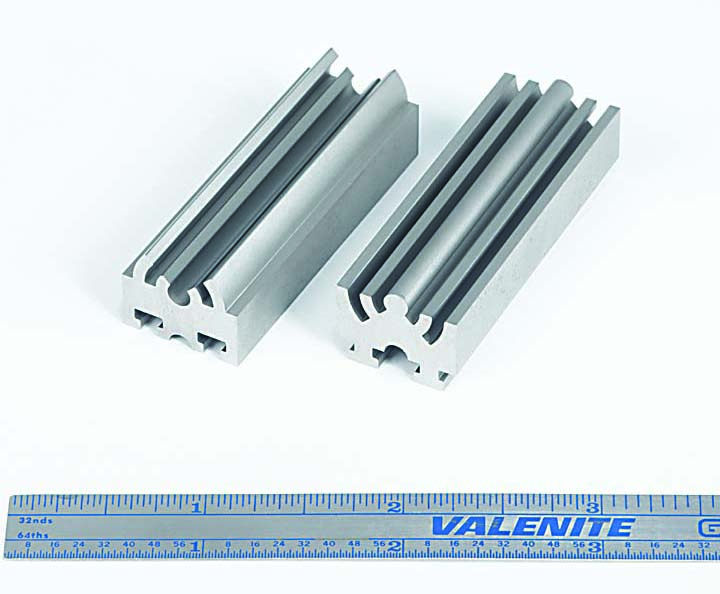
He also noted that EDM is a good fit for automated processes, including lights-out operations.
“There doesn’t need to be someone there babysitting the machine,” Brown said. With wire EDM, “as long as you have wire on the spool, the machine is going to run. But with a milling process, you’ve got to be concerned about how long your cutting tools are going to last.”
On the other hand, EDM is slow compared with other machining options.
“EDM is the last process you want to use to make something because it’s the most time-consuming process,” Brown said. “So if you can make it another way, you probably want to do it on a mill or lathe.”
Even though EDM machines might generate 300,000 sparks per second, Ostini noted, typical wire EDM speeds today are in the range of 37 to 42 sq. in. per hour, whereas milling speeds could be up to 200 sq. in. per hour.
Coward pointed out, however, that certain shapes and features simply cannot be milled. Or maybe you can mill them, he said, but if they’re really intricate, they actually could take longer to mill than to make with a wire EDM machine.
“Wire EDM is very easy to program,” he said, “and you can get things like very tight corner radii that you’re not going to be able to do in a mill unless you go down to very small cutters and then go in and pick out those corners. But that’s going to be very inefficient in terms of cost because those cutters are very expensive and they’re going to wear fast.”
In addition to its speed disadvantage in most cases, Brown mentioned another EDM downside that can be a cause for concern, especially in the aerospace industry. Although wire EDM makes it easier to put precise contours in titanium aerospace parts and wastes much less of that expensive material than conventional machining, he noted that the process also creates a heat-affected zone in parts, so aerospace users must make sure that the resulting properties in that zone are within allowable limits.
EDM in Use
However, Coward said that isn’t the major issue it was 30 years ago when the heat generated by EDM produced microcracking that caused weak points in part material. He said that’s no longer the case today thanks to more sophisticated EDM generators. As a result, he noted that sinker EDM is used to make a variety of jet engine parts that would be very difficult to produce any other way.
He also pointed out that wire EDM currently is used to make stents and other medical components with intricate designs and fine details.
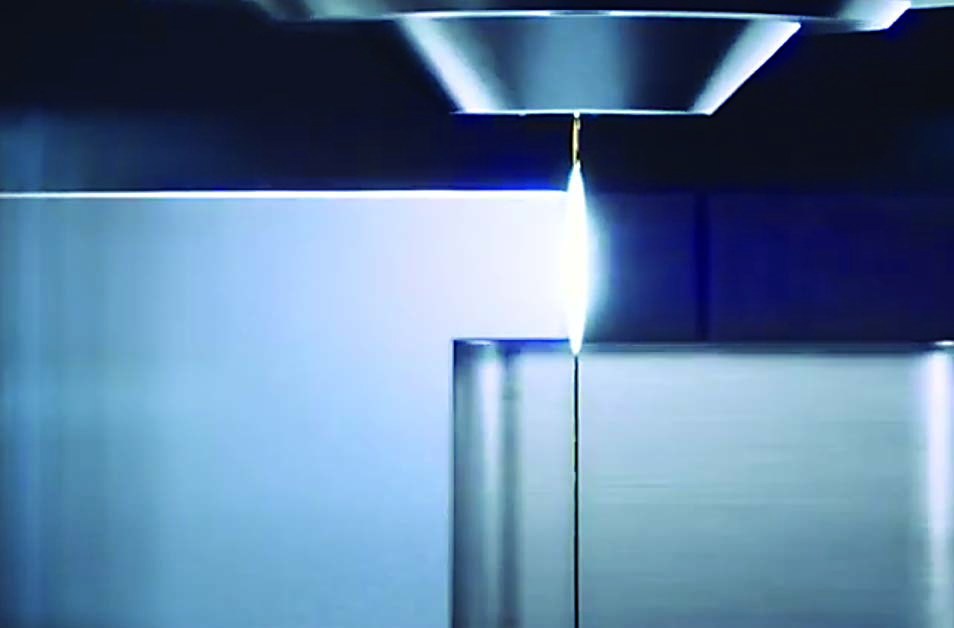
“Especially as implants get smaller and smaller,” Coward said, “wire EDM lends itself to creating those types of parts.”
Traditionally, a common application for EDM was creating mold cavities. But he said hard milling has supplanted EDM as the go-to option for this task.
“Now we can mill those (cavities) with the accuracy and finish that we need,” Coward said.
However, there’s still an important role for sinker EDM in mold making: creating support ribs in molds that help plastic parts hold their shape.
“Those are deep, thin ribs,” Coward said, “and it’s hard to get in and machine those with a mill.”
Milling a deep cavity that is very thin would require a very small endmill capable of reaching the area to be cut.
“Depending on how small the endmill is, you can only go so deep because eventually you’ll get to a stress point that will cause it to break,” Ostini said. “Whereas with sinker EDM, you could go 4" deep (to create a feature) only 0.03" thick.”
In addition, he noted that wire EDM can be used to create very thin through cavities that normally would be beyond the capabilities of other machining options. He also pointed out that a milling machine cannot produce sharp corners inside a cavity or make a deep, sharp-cornered cavity. He explained that is because endmills have diameters rather than sharp edges, so they would leave radiuses in the corners of cavities. With sinker EDM, on the other hand, users can create electrodes with sharp edges that will produce the desired sharp corners.
Another attractive feature of EDM is its ability to melt its way through the most challenging materials.
“As materials get harder and harder today, milling machines have to become beefier and stronger to cut through these materials accurately,” Ostini said. With EDM, however, “we are using a spark that can get to almost 20,000 degrees Celsius, which means we are not worried about the hardness of the material.”
Recent Advances
Today, wire and sinker EDM users also are benefiting from recent developments aimed at making the processes more economical and easier to use. One such development is the introduction of iWire technology by GF Machining Solutions. Ostini said iWire automatically adjusts the speed of a wire-dispensing spool to match cutting conditions at any given moment. If the thickness of a material being cut suddenly went from 3" to 0.5", for example, he said most EDM machines would have to be adjusted manually to slow the wire spool speed accordingly. By contrast, he explained, iWire would sense the change in material thickness and automatically make the appropriate adjustment. Prompt automatic changes of this kind can reduce wire consumption in a typical EDM process by 30% to 40%, he said.
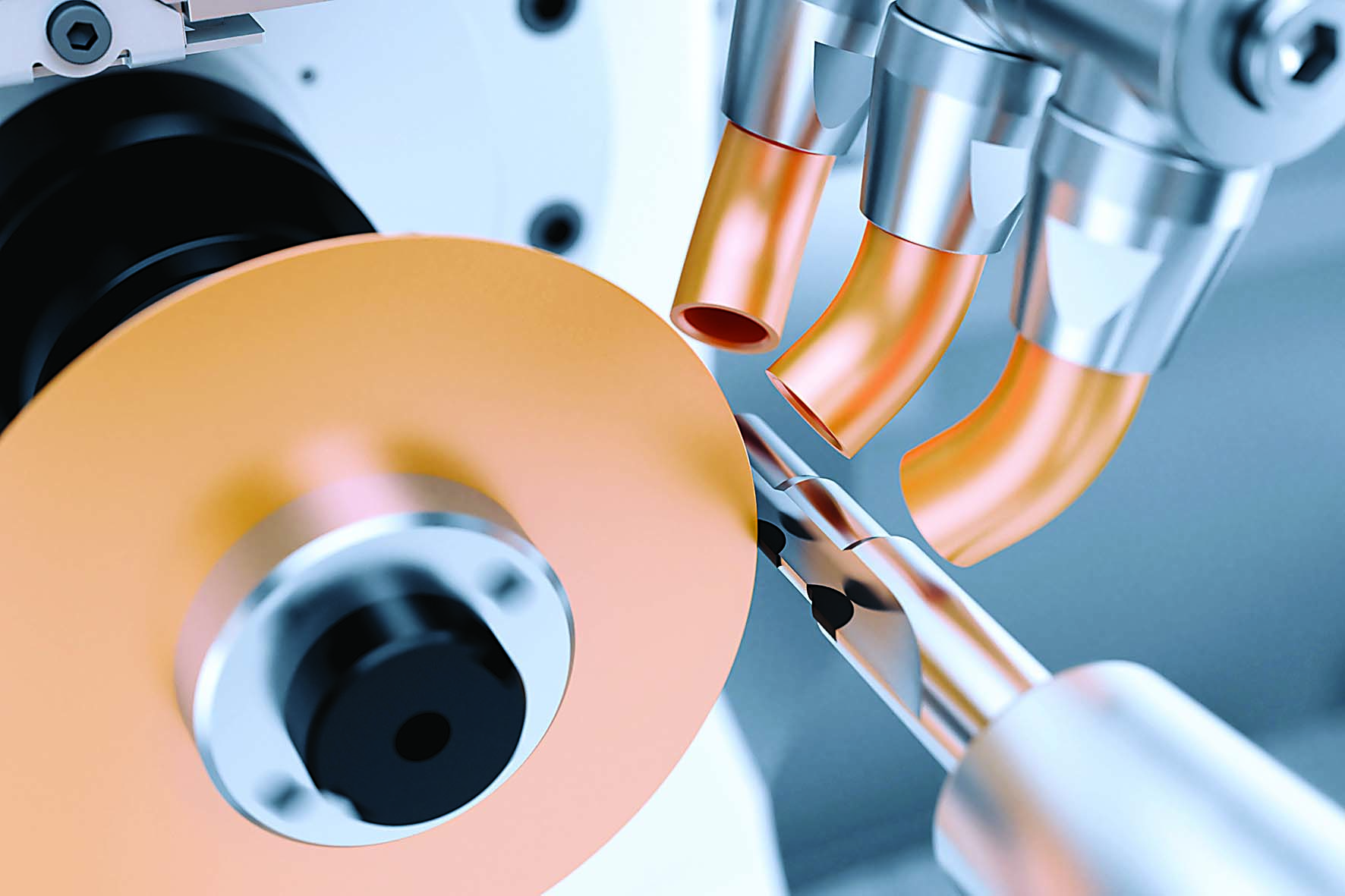
Another noteworthy development in EDM technology is the new Quick View Dynamic Content Assistant, or QV Assist, part of an update to Makino’s Hyper-i wire EDM control. In the control window, QV Assist automatically displays whatever information operators need that relates to the current machine status. When the machine is running, for example, QV Assist will display information like remaining wire and time in the cut.
“In the old Hyper-i, you had to know what page to go to to find that information,” Coward said. “The idea behind QV Assist is to bring that information up to the operator. That is going to assist newer operators and less experienced EDM guys in learning how to run the machine.”
To improve sinker EDM processes, Makino also has introduced the Adapti-Spark Function, or AiSF, an adaptive control function that automatically adjusts the discharge current and “jump” settings (those that relate to the electrode’s up-and-down movements along the z-axis) based on machining conditions. He said AiSF can cut EDM cycle time by 15% and reduce electrode wear by 80%, which could eliminate the need to make a second or third electrode to machine a shape.
For toolmaking applications involving polycrystalline diamond, Vollmer recently unveiled the VHybrid 260, a machine that combines a grinder with an EDM generator. The grinder can be used to produce the carbide part of a tool while the EDM process shapes the PCD tip, which is difficult to grind. Brown explained that the VHybrid 260 erodes PCD with a disk-shaped electrode made of copper tungsten in a process similar to sinker EDM.
Introduced at IMTS last year, he said the VHybrid 260 could be a game changer for toolmakers struggling with the challenges of machining PCD.
“I am excited about the machine and how it’s going to make manufacturing of PCD tools much easier,” Brown said.
Contact Details
Contact Details
Contact Details
Related Glossary Terms
- computer numerical control ( CNC)
computer numerical control ( CNC)
Microprocessor-based controller dedicated to a machine tool that permits the creation or modification of parts. Programmed numerical control activates the machine’s servos and spindle drives and controls the various machining operations. See DNC, direct numerical control; NC, numerical control.
- electrical-discharge machining ( EDM)
electrical-discharge machining ( EDM)
Process that vaporizes conductive materials by controlled application of pulsed electrical current that flows between a workpiece and electrode (tool) in a dielectric fluid. Permits machining shapes to tight accuracies without the internal stresses conventional machining often generates. Useful in diemaking.
- endmill
endmill
Milling cutter held by its shank that cuts on its periphery and, if so configured, on its free end. Takes a variety of shapes (single- and double-end, roughing, ballnose and cup-end) and sizes (stub, medium, long and extra-long). Also comes with differing numbers of flutes.
- gang cutting ( milling)
gang cutting ( milling)
Machining with several cutters mounted on a single arbor, generally for simultaneous cutting.
- grinding
grinding
Machining operation in which material is removed from the workpiece by a powered abrasive wheel, stone, belt, paste, sheet, compound, slurry, etc. Takes various forms: surface grinding (creates flat and/or squared surfaces); cylindrical grinding (for external cylindrical and tapered shapes, fillets, undercuts, etc.); centerless grinding; chamfering; thread and form grinding; tool and cutter grinding; offhand grinding; lapping and polishing (grinding with extremely fine grits to create ultrasmooth surfaces); honing; and disc grinding.
- hardness
hardness
Hardness is a measure of the resistance of a material to surface indentation or abrasion. There is no absolute scale for hardness. In order to express hardness quantitatively, each type of test has its own scale, which defines hardness. Indentation hardness obtained through static methods is measured by Brinell, Rockwell, Vickers and Knoop tests. Hardness without indentation is measured by a dynamic method, known as the Scleroscope test.
- heat-affected zone
heat-affected zone
That portion of the base metal that was not melted during brazing, cutting or welding, but whose microstructure and mechanical properties were altered by the heat.
- lathe
lathe
Turning machine capable of sawing, milling, grinding, gear-cutting, drilling, reaming, boring, threading, facing, chamfering, grooving, knurling, spinning, parting, necking, taper-cutting, and cam- and eccentric-cutting, as well as step- and straight-turning. Comes in a variety of forms, ranging from manual to semiautomatic to fully automatic, with major types being engine lathes, turning and contouring lathes, turret lathes and numerical-control lathes. The engine lathe consists of a headstock and spindle, tailstock, bed, carriage (complete with apron) and cross slides. Features include gear- (speed) and feed-selector levers, toolpost, compound rest, lead screw and reversing lead screw, threading dial and rapid-traverse lever. Special lathe types include through-the-spindle, camshaft and crankshaft, brake drum and rotor, spinning and gun-barrel machines. Toolroom and bench lathes are used for precision work; the former for tool-and-die work and similar tasks, the latter for small workpieces (instruments, watches), normally without a power feed. Models are typically designated according to their “swing,” or the largest-diameter workpiece that can be rotated; bed length, or the distance between centers; and horsepower generated. See turning machine.
- milling
milling
Machining operation in which metal or other material is removed by applying power to a rotating cutter. In vertical milling, the cutting tool is mounted vertically on the spindle. In horizontal milling, the cutting tool is mounted horizontally, either directly on the spindle or on an arbor. Horizontal milling is further broken down into conventional milling, where the cutter rotates opposite the direction of feed, or “up” into the workpiece; and climb milling, where the cutter rotates in the direction of feed, or “down” into the workpiece. Milling operations include plane or surface milling, endmilling, facemilling, angle milling, form milling and profiling.
- milling machine ( mill)
milling machine ( mill)
Runs endmills and arbor-mounted milling cutters. Features include a head with a spindle that drives the cutters; a column, knee and table that provide motion in the three Cartesian axes; and a base that supports the components and houses the cutting-fluid pump and reservoir. The work is mounted on the table and fed into the rotating cutter or endmill to accomplish the milling steps; vertical milling machines also feed endmills into the work by means of a spindle-mounted quill. Models range from small manual machines to big bed-type and duplex mills. All take one of three basic forms: vertical, horizontal or convertible horizontal/vertical. Vertical machines may be knee-type (the table is mounted on a knee that can be elevated) or bed-type (the table is securely supported and only moves horizontally). In general, horizontal machines are bigger and more powerful, while vertical machines are lighter but more versatile and easier to set up and operate.
- milling machine ( mill)2
milling machine ( mill)
Runs endmills and arbor-mounted milling cutters. Features include a head with a spindle that drives the cutters; a column, knee and table that provide motion in the three Cartesian axes; and a base that supports the components and houses the cutting-fluid pump and reservoir. The work is mounted on the table and fed into the rotating cutter or endmill to accomplish the milling steps; vertical milling machines also feed endmills into the work by means of a spindle-mounted quill. Models range from small manual machines to big bed-type and duplex mills. All take one of three basic forms: vertical, horizontal or convertible horizontal/vertical. Vertical machines may be knee-type (the table is mounted on a knee that can be elevated) or bed-type (the table is securely supported and only moves horizontally). In general, horizontal machines are bigger and more powerful, while vertical machines are lighter but more versatile and easier to set up and operate.
- polycrystalline diamond ( PCD)
polycrystalline diamond ( PCD)
Cutting tool material consisting of natural or synthetic diamond crystals bonded together under high pressure at elevated temperatures. PCD is available as a tip brazed to a carbide insert carrier. Used for machining nonferrous alloys and nonmetallic materials at high cutting speeds.
- polycrystalline diamond ( PCD)2
polycrystalline diamond ( PCD)
Cutting tool material consisting of natural or synthetic diamond crystals bonded together under high pressure at elevated temperatures. PCD is available as a tip brazed to a carbide insert carrier. Used for machining nonferrous alloys and nonmetallic materials at high cutting speeds.
- ram EDM
ram EDM
Process using a shaped electrode made from graphite or copper. The electrode is separated by a nonconductive liquid and maintained at a close distance (about 0.001"). A high DC voltage is pulsed to the electrode and jumps to the conductive workpiece. The resulting sparks erode the workpiece and generate a cavity in the reverse shape of the electrode, or a through-hole in the case of a plain electrode. Permits machining shapes to tight accuracies without the internal stresses conventional machining often generates. Also known as “die-sinker” or “sinker” electrical-discharge machining.
- wire EDM
wire EDM
Process similar to ram electrical-discharge machining except a small-diameter copper or brass wire is used as a traveling electrode. Usually used in conjunction with a CNC and only works when a part is to be cut completely through. A common analogy is wire electrical-discharge machining is like an ultraprecise, electrical, contour-sawing operation.
Contributors
GF Machining Solutions LLC
800-282-1336
www.gfms.com
Makino Inc.
513-573-7200
www.makino.com
Vollmer of America Corp.
412-278-0655
www.vollmer-group.com/en-us





